Women's
monthly magazines:
New Woman to Over 21
This page links to profiles of women's monthlies, many of which are known as glossies or slicks because of their high production values and upmarket editorial. Some weeklies – such as Grazia and Riva – are included because of their attempts to establish themselves as weekly glossies. The main index page is here. The titles – past and present – are arranged alphabetically on the following pages:
- 19 to Cosmopolitan
- Easy Living to Grazia
- Harper's Bazaar to More!
- New Woman to Over 21 [this page]
- Queen to Riva
- Scene to Zest
- Table of top 5 sellers
- Key facts on women's monthlies
Main women's monthly index page.
New Woman (UK)Murdoch Magazines / Emap, monthly, July 1988- Launch marketing budget was £500,000. Rupert Murdoch had bought the US original
in 1984 (it was launched in 1973) and it marked his first solo magazine
in the UK (Elle and Sky were joint ventures with
Hachette). Editors include: Frankie McGowan; Gill Hudson |
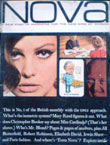 The first issue in 1965 of the legendary Nova |
Nova [closed]Newnes/IPC, monthly, March 1965 – October 1975Launched with Harry Fieldhouse, who had come from Tatler, as editor. The publishing company was Newnes merged into what was to become IPC. Dennis Hackett took over after six months (having been editor at Jocelyn Stevens' Queen, which was selling about 50,000) to create a groundbreaking magazine. Sales peaked in the year after launch at 159,496, before declining to 74,972 in the first half of 1975. In comparison, Vogue sold about 120,000 an issue, and Cosmopolitan burst on to the scene with a first ABC sales figure of 352,272. The first designer was Harri Peccinotti,
who carried on as a freelance photographer for the magazine. Peter
Crookston from Sunday Times Magazine took over in 1969
with David Hillman joining him as art director. Editors: Harry Fieldhouse
(Mar-Aug 65); Dennis Hackett (Sep65-Dec 67); Bill Smithies (Jan-Jun
68); Dennis Hackett (Jul 68-Apr 69); Peter Crookston (May/Jun 69-
Nov 70); Gillian Cooke (Dec 70- Oct 75). The book Nova 1965-1975,
compiled by David Hillman and Harri Peccinotti, and edited by David
Gibbs, was published by Pavilion Books in 1993. IPC tried to revive the title
in 2000. |
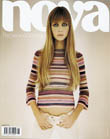 Revived Nova magazine under Deborah Bee |
Nova (2000) [closed]IPC Media, monthly, March 2000 – June 2001An attempt by IPC to resurrect a magazine that had been the style bible for British women in the 1960s and 1970s – but lasted just 13 issues. Deborah Bee, ex Scene, launched the title, but was ousted after just two issues for Sunday Times style editor Jeremy Langmead. Final ABC sales 75,142. The content seen as edgy and not mainstream. A Guardian article (3/5/01, p5) said IPC was attempting to trim loss-making titles ahead of a stock market flotation in 2002 (in fact, Time Warner bought the company). IPC profile |
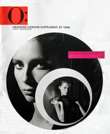 Fashion quarterly from the Observer |
O:Observer supplement, quarterly, Winter 2005 -Fashion quarterly produced by photography-led Tank for Sunday’s Observer newspaper. Followed sport and music monthlies, in addition to the weekly magazine. Large format (266mm by 320mm) enables O: to show off the photography and it is thick enough with perfect binding to feel like a real magazine. Carried 26 pages of adverts, including a four-page advertorial for Getty Images/Cointreau, in its 100 pages. Observer (Guardian) profile |
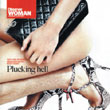 Observer Woman will sit alongside other monthly supplements: Sport, Food and Music as well as fashion quarterly O: |
Observer WomanObserver supplement, quarterly, January 2006Free supplement with Sunday paper. perfect bound with 76pp. Edited by Nicola Jeal with art direction by Carolyn Roberts. Saw itself as appealing to men as well woman. Observer (Guardian Media Group) profile |
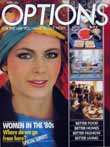 Options - April 1982 launch issue under editor Penny Radford. Its selling line was 'For your way you want to live now.' The spine copy read: 'Better food/better homes/better fashion/better living'. Its 236 pages cost 60p 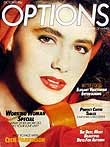 Options – October 1984. Under editor Sally O'Sullivan the selling line had evolved: 'For your way of living.' The spine copy was the same. |
Options [closed]Carlton/Reed/IPC, monthly, April 1982 – March 1999Options was launched by Carlton Magazines, a company founded by Terry Hornett. The company worked with IPC, which managed advertising sales and distribution. The title, for a core audience of 25- to 35-year olds, had a good start, beating the 260,000 sales target set for its launch. However, sales fell back to about 220,000 in the first half of 1983 and it was a long, slow, decline after that. As early as 1983, publisher Colin Reeves Smith told Campaign he was considering replacing Sally O'Sullivan as editor. However, Carlton used the title as a base for product development, including Options for Men, a quarterly supplement (December 1984). Hornett sold Carlton to Reed in 1987 (with other titles including Options, Looks, Country Homes and Interiors and Woman's World). By 1988, Carlton was considering launching the OM supplement as an independent magazine, though this never came to pass. The women’s market did hot up though, with IPC launching Marie Claire and Essentials and Carlton founding the short-lived Riva (with O’Sullivan as editor). Options for babies – Boptions – was another supplement. In April 1989, Reed, which owned both Carlton and IPC, merged the former company into the latter. Options moved into IPC’s King's Reach Tower. In the same year, as part of a marketing campaign, a novel – Your Royal Hostage by Antonia Frazer was used as a cover gift on its September issue and the magazine was promoted on TV. In November 1991, Maureen Rice became editor and a relaunch was announced, with the magazine aiming for a younger readership (the average age then being 29). Publisher Heather Love said: ‘The caterpillar will become a butterfly.’ Sales had slipped, with a 15 per cent drop in its latest ABC figure from 178,343 for January to June 1990 to 150,067 in 1991. In July 1992, the magazine gained some notoriety when it was mentioned in a highly publicised libel case. Jani Allan, a South African journalist, sued Channel 4 over a television programme, which she said suggested she had an affair with the neo-Nazi leader Eugene Terre-Blanche. It came out in evidence that she had received about £20,000 plus costs from Options after it reported her alleged affair. A similar sum had come from the Evening Standard. The Channel 4 trial pitted two of the country’s leading libel lawyers, Peter Carter-Ruck prosecuting for Allan, and George Carman QC, defending Channel 4. She lost the case and was faced with a £300,000 bill for legal costs. In 1994, IPC ran a London-based poster campaign to support the
May issue. The posters read: 'Smart women read Options'
but, by 1997, sales had fallen to 127,000. IPC relaunched what was
then an ‘ailing’ title. July marked the new-look magazine.
It was not enough. In January 1999, IPC announced the closure of
Options. Despite the relaunch, circulation had fallen to
119,178. The March issue was the last. IPC’s attention had
been drawn elsewhere – it had just announced 200 redundancies
– but was also planning Project B, which was revealed a year
later as a revived Nova. |
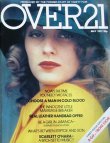 Over 21: first issue cover, May 1972. The tag line above the masthead reads: 'Produced by the former staff of Vanity Fair.' |
Over 21 [closed]Ms Publishing / Morgan Grampian / Spotlight Publications, monthly, May 1972-June 1988 By 1981, Over 21 was in the hands of Morgan Grampian, part of Fleet Holdings (Trafalgar House). In 1987, it spun off a quarterly called Beauty Now. By 1988, it was owned by Spotlight Publications (part of Express publisher United Newspapers), which tried to sell the title, but it closed that year with a circulation of 92,000 a month. Slaughter had made her name launching Honey in 1960. She had left Over 21 in 1979 to go
to the Sunday Times and also launched the Express colour
magazine, working as associate editor with her second husband, the
former London Evening Standard editor, Charles Wintour (making Anna
Wintour of British and US Vogue her step-daughter). Then launched Working
Women. |


